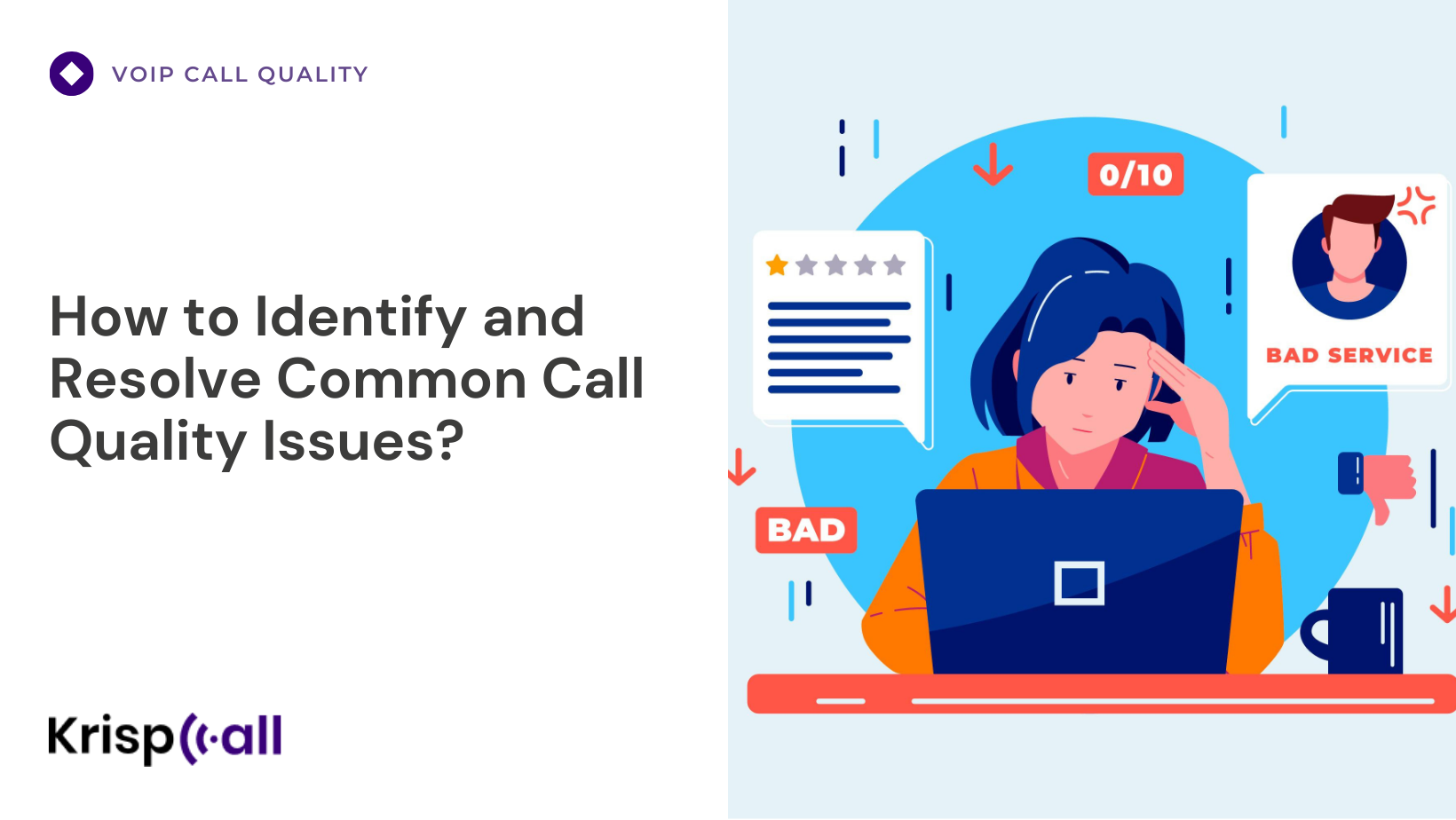Call quality is a crucial factor for business; it keeps customers happy and increases the company’s professionalism. But sometimes, there are issues with phone calls, which lead to disrupted communication.
In this guide, we will explore how to identify and address common call quality issues to ensure smooth and effective communication for your business.
🔑 Key Highlights
- Call quality is the performance of audio, including clarity and reliability.
- Two major types of call quality issues are audio issues and connection issues.
- Best practices to improve call quality are quality of service QoS and jitter buffer.
- You can also increase the Quality of Service (QoS) by using wired Ethernet connections, employing jitter buffers, and turning off Bluetooth devices.
- Clear calls lead to shorter call durations, reducing overall call center operating costs.
What is call quality?
Call quality is the performance of the audio, including clarity and reliability, which helps to understand the communication during phone calls or VoIP calls.

Voice over Internet Protocol (VoIP) calls refer to the clarity and responsiveness of voice calls through Internet packet delivery. It includes factors such as stable network, bandwidth, and reliability of VoIP service providers.
Types of call quality issues
Call quality can be divided into two main factors one is audio problems, and another is connection issues. These are both common problems that we have to face in our daily lives. So, let’s explore these common issues:
| Issue | Description | Solution |
| Delayed Audio | The long delay in audio transmission leads to awkward pauses and misunderstandings. | Choose a reliable internet service provider (ISP) Upgrade routers or equipment Measure latency with a VoIP Latency Test. |
| Background Noise | Distraction is caused by constant background noise that interferes with communication. | Mute microphone when not speaking Use noise-cancelling headphones Employ sound-absorbing materials. |
| Echo in Call | Electrical imbalances are causing echo or latency in VoIP calls. | Use microphones designed for VoIP applications Minimize electrical interference Rectify or replace faulty connections |
| Robotic Voice | Packet loss or discard leads to speech sounding artificial or robotic. | Utilize a wired internet connection Avoid sending large files during a call |
| Call Drop | Frequent disconnection due to weak network connections or bandwidth issues. | Ensure stable network connections Address insufficient bandwidth or network congestion |
| One Way Audio | Only one party can hear the other, which is commonly caused by firewall or NAT complications. | Adjust firewall settings Check device updates Consider router configuration changes Contact VoIP service provider for assistance |
6 Common Call Quality Issues & Their Solutions
Audio problems
Audio is the main communication factor; if the audio isn’t clear, it’s hard for us to understand each other. Some of the errors we can find in the audio problems are:
1. Delayed audio
Delayed audio is the most common issue; a long delay in audio transmission creates an awkward pause during conversations. It can also lead to misunderstandings and missing important cues, making it challenging to share ideas.
Delayed audio can cause problems during calls because people might not know when to talk or when it’s their turn. This confusion can lead to interruptions and make it hard for everyone to understand each other.
Some of the best methods to deal with delayed audio are:
- Choose the right internet service provider (ISP)
- Upgrade the routers or equipment
- Measure latency with a VoIP Latency Test
2. Background noise
Background noise can be very irritating, especially when you cannot do anything about it. Constant distraction can create misunderstandings with clients, Draw participants’ attention away from the conversation, and make it harder to focus on the discussion.
You can use these methods to reduce background noise.
- Mute microphone when not speaking
- Get noise-cancelling headphones
- Employ materials that absorb sounds
3. Echo incall
Echo, also known as latency, occurs due to electrical imbalances in impedance feedback. In VoIP calls, this can happen when a small amount of the outgoing signal leaks back into the microphone instead of being wholly directed toward the speaker. It may occur for these potential reasons:
- Improper microphone placement
- Double talk
- Network latency and
- Distance of call
So, how we can reduce the echo in VoIP calls here are some points:
- Utilize microphones specifically designed for VoIP applications.
- Minimize electrical interference from devices connected to phone cables.
- Rectify or replace faulty connections.
4. Robotic voice
Robotic voice, also known as jitter, typically occurs when there is a significant amount of packet loss or packet discard caused by jitter. While the packet loss concealment algorithms in Voice over IP (VoIP) systems can handle occasional packet loss, excessive loss can result in speech that sounds robotic.
When many packets are lost, the speech might sound “robotic.” The algorithm that tries to cover up the lost packets can sometimes make the voice sound artificial or robotic. You can solve this using a wired internet connection and avoid sending big files during a call.
Connection issues
Another major issue for call dropouts is connection. Like audio problems, a connection issue can result in delays or latency in audio transmission. This interruption disrupts the conversation flow and reduces the call experience’s overall quality.
1. Call drop
When the network connections are weak, it can lead to frequent call drops. VoIP calls require a certain number of stable connections to transmit audio data smoothly. When a call drops due to some connection issue, it indicates insufficient bandwidth or network congestion, making it more challenging to make further calls.
When a call drops, it’s like losing some of the conversation. This can happen because the internet connection is too busy, slow, or has problems. When this occurs, some pieces of the audio information get lost or arrive in the wrong order, making it hard for the call to continue smoothly. This can happen because the internet connection is too crowded, slow, or has problems.
2. One-way audio
Although one-way audio is a common issue among VoIP calls, firewalls can block specific ports needed for VoIP traffic, and NAT (Network Address Translation) can cause complications by mixing up the destination for the audio stream.
These are a few issues with one-way audio.
- Microphone problems
- Packey loss
- High latency
- Outdated equipment
- Asymmetric routing
You may fix these problems:
- Adjust the firewall setting.
- Check the device updates.
- If you use a router behind the modem, consider putting it in bridge mode.
- Contact your VoIP service provider.
7 Best practices to resolve your call quality
We need to understand that the above can interfere with your conversations. Call quality monitoring is essential to communications; it can detect echoes, distortion, and one-way audio. Quality is key to your calls, so let’s discuss improving your call quality during conversations.
Choose a good headset.
Selecting a good headset can easily resolve your call quality issues. Some headsets are specially designed for VoIP calls, reducing background noise. You can use wired headphones for more stable audio.
Check the internet connection.
Check the internet connection before making the calls. With steady connections, there are few chances of interruptions and glitches in the data stream. A stable connection also reduces the latency, which minimizes the possibility of lag between the participants.
Update software
Another best method to resolve call quality issues is upgrading your software. It fixes bugs like dropped calls, echo, static, or choppy audio. Some updates ensure compatibility with the latest network technologies and devices. It also includes security patches that protect your calls from being intercepted.
Quality of service setting (QoS)
QoS (Quality of Service) measures, enhances, and ensures data bandwidth and error rates. Think of a playground during recess. Regular games are like kids playing soccer, while a child gets hurt and needs help urgently. QoS is like the teacher ensuring the hurt child gets immediate attention by calling for help and clearing the way. This ensures the injured child receives the care they need quickly and without delay.
Choose a wire ethernet connection.
To boost call quality, make sure you are using cable instead of Wi-Fi. Although Wi-Fi is convenient, it may not always be reliable for voice calls. Ethernet cable provides a stable connection directly to the router, which makes it less stressful to worry about weak signals or disrupt your call.
Employ a jitter buffer.
It is a way of managing the voice packets on VoIP calls. It converts your conversations into a series of small pieces of data called data packets. Jitter buffers reorder packets to maintain sequence and prevent playback issues. They briefly hold packets to ensure a smooth, steady delivery, usually imperceptible to callers.
Turn off all Bluetooth devices.
You might find this unexpected. How does using Bluetooth affect a VoIP call over the internet? Here’s the thing. Bluetooth and WiFi operate on similar radio frequency ranges for data transmission. So, when the frequency is crowded, it can lead to more problems for your call.
Importance of call quality in a business
Call quality is crucial for business. It makes a negative impression on customer satisfaction and brand image, so why a good call quality is essential:
- Reduce support cost: Clear and smooth calls eliminate repeat calls. Call quality leads to shorter call durations, which makes the agents accessible. They can focus on more customer inquiries and reduce overall call center operating costs.
- Brand reputation: Crystal-clear calls play a major role in shaping a business’s brand reputation. High-quality calls reflect professionalism and effectiveness. Customers trust businesses more when their calls are clear, reliable, and credible.
- Professionalism: Precise and reliable phone calls make a business seem more professional because they demonstrate its ability to communicate effectively with customers. It creates a positive impression of the company and its competence.
- Customer satisfaction: When customers can hear and understand the information provided without disruptions or distortions, they are more likely to have a positive experience and feel valued by the business.
- Sales opportunities: Better call quality means happier customers. Customers who can hear clearly and talk without problems are likelier to buy things from the company. So, improving call quality can help sell more products or services.
KrispCall: Make International Calls Without Worrying about Poor Call Quality
Introducing KrispCall, your solution for making international calls without any hassle. With KrispCall, you won’t have to deal with poor call quality. Our algorithm blocks out background noise so you can hear clearly. And the best part? You can use KrispCall over the Internet, making it easy and affordable to call anyone, anywhere.
Try KrispCall now and see how easy international calling can be!
Conclusion
Identifying and resolving call quality issues is crucial for effective communication, especially for a VoIP user. Call quality is all about the clarity and reliability of audio during phone or VoIP calls. A smooth call requires a stable network, bandwidth, and a proper service provider.
Remember, prioritizing good quality calls offers multiple benefits like reduced cost, brand reputation, and sales opportunities. By prioritizing clear communication, you can ensure a positive customer experience, enhance your brand reputation, and ultimately achieve your business goals.
FAQs
What’s the first thing I should do if I experience call quality issues?
The first major thing you can do is check the signal strength. Make sure your internet connection has a strong signal. If the problem still occurs, try restarting the device or switching to a different network.
Wired or Wi-Fi? Which is better for VoIP calls?
A wired connection is the best option if you want to use it for VoIP calls. With a wired connection, your device is directly connected to the network through an Ethernet cable, providing a consistent and uninterrupted data flow. Meanw





